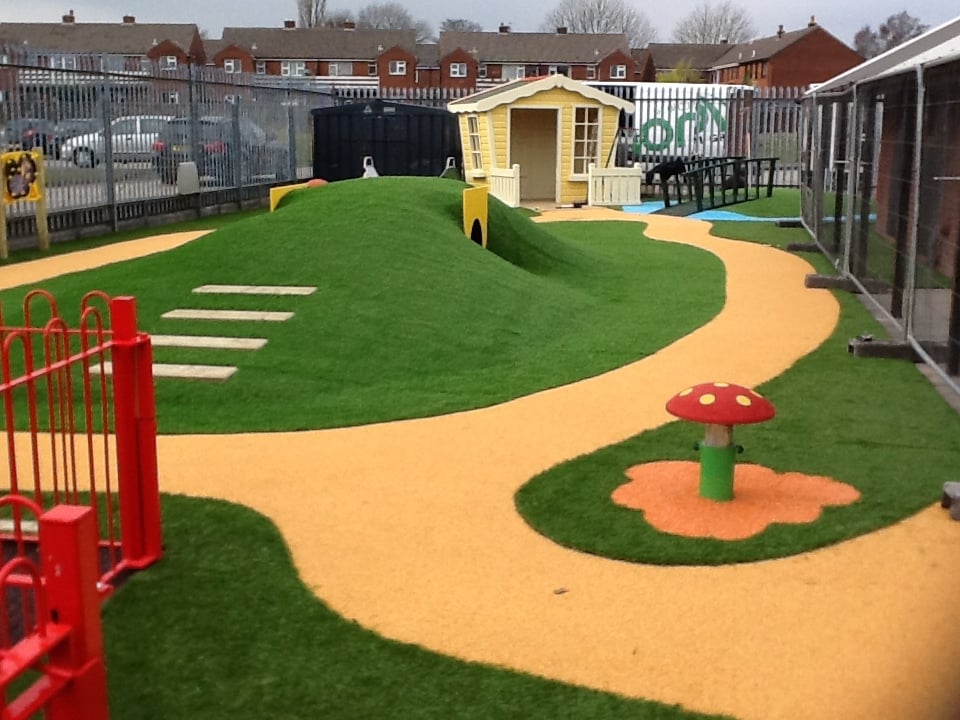Why Choose Artificial Grass for School Playgrounds
Artificial grass offers numerous advantages for school playgrounds. Here are some key reasons why schools are opting for artificial grass:
Safety First
One of the primary concerns when it comes to school and nursery playgrounds is safety. Artificial turf provides a cushioned surface that helps reduce the risk of injuries from falls. By installing a shockpad underlay beneath the artificial grass, you can further enhance the safety of the play area.
The shock pad absorbs impact and provides a softer landing surface, meeting safety standards and ensuring peace of mind for parents and school staff.
Low Maintenance
Maintaining natural grass in a school playground can be time-consuming and costly. Artificial grass, on the other hand, requires minimal maintenance. You won’t need to mow, water, or fertilise the grass, saving both time and money.
Additionally, artificial grass is resistant to wear and tear, making it an ideal choice for high-traffic areas.
Durability and Longevity
School playgrounds experience heavy foot traffic and constant use, which can take a toll on natural grass. Artificial grass, however, is designed to withstand the demands of a busy playground. It is highly durable and can withstand regular play activities without showing signs of wear.
With proper installation and maintenance, artificial grass can last for many years, providing a reliable and attractive surface for children to enjoy.
All-Weather Play
Unlike natural grass, artificial grass can be used in all weather conditions. Whether it’s a hot summer day or a rainy afternoon, the outdoor play area will remain accessible and usable.
Artificial lawn has excellent drainage capabilities, allowing water to flow through the surface, and preventing puddles and mud from forming. This ensures that children can continue to play and have fun regardless of the weather.
The Installation Process
Installing artificial grass products in a school playground requires careful planning and execution. Here are the key steps involved in the installation process:
1. Preparation
Before installing artificial grass, it’s essential to prepare the playground area properly. Start by removing any existing grass or vegetation. Use a turf cutter to remove the top layer of soil to create a level base. Clear the area of any debris or rocks that could interfere with the installation process.
2. Weed Membrane
To prevent weed growth, lay a weed membrane over the prepared area. The weed membrane acts as a barrier, preventing weeds from penetrating through the artificial grass.
3. Stone Base
Next, create a stone base by spreading a layer of crushed stone or hardcore over the weed membrane. This base provides stability and helps with drainage. Compact the stone base using a vibrating plate compactor to ensure a firm and level surface.
You may also consider a shockpad for extra safety.
4. Lay Artificial Grass
Roll out the artificial grass over the prepared stone base. Ensure that the grass is positioned correctly, with the pile facing in the desired direction. Trim the edges of the grass to fit the playground area using a sharp utility knife.
5. Secure the Grass
Using ground pins or staples, secure the edges of the artificial grass to the ground. This will prevent the grass from shifting or moving during play.
6. Joining Tape
If the playground area is larger than the width of the artificial grass rolls, you may need to join multiple pieces together. Lay joining tape along the seam where the rolls of grass meet, ensuring that the shiny side is facing up. Apply adhesive to the tape and press the edges of the grass onto the tape, creating a secure bond.
Tips for a Successful Installation
Here are some additional tips to ensure a successful installation of artificial grass in school playgrounds:
Use a Shockpad Underlay
Consider using a shock pad underlay beneath the artificial grass. This additional layer provides extra cushioning and enhances the safety of the play area.
Regularly Inspect and Maintain the Playground
After the installation is complete, regularly inspect the playground for any signs of wear or damage. Replace any worn-out or damaged areas of the artificial grass promptly to ensure the safety of the children.
Provide Shade and Seating Areas
Consider incorporating shade structures and seating areas within the playground to provide a comfortable and enjoyable environment for children and supervising adults. This will encourage longer play sessions and enhance the overall experience.
Installing artificial grass in school playgrounds offers numerous benefits, including increased safety, low maintenance, durability, and all-weather play. By following the proper installation process and incorporating practical tips, schools can create attractive and functional play areas for children to enjoy.
Artificial grass provides a reliable and long-lasting solution that will withstand the demands of a busy school environment. Transform your school playground with artificial grass and provide an engaging and safe play area for generations of children to come.


